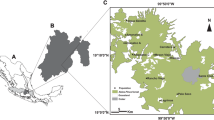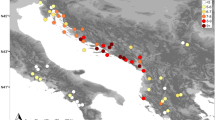Abstract
British S. vulgaris are classified as aseparate subspecies, S. v. leucourus, tomainland Europe. While S. vulgaris is notunder threat across most of its Eurasian range,in Britain, Ireland and Italy populations aredeclining, mainly due to the introduction ofthe American grey squirrel (S.carolinensis). In this study, we conducted anextensive survey of mitochondrial DNA variationin British S. vulgaris populations and apreliminary survey of continental Europeanpopulations. Our main aims were to determinethe extent to which any populations of S.vulgaris in Britain are partially or whollythe product of artificial translocation of redsquirrels from continental Europe, and whethercontinental population variation will provideinformation on post-glacial reafforestationpatterns in Europe. We found that the majorityof extant populations of British S.vulgaris are of continental ancestry, manywith a very recent (last 40 years) Scandinavianancestry. The Scandinavian haplotype hasrapidly become the most dominant innortheastern Britain, despite not appearing innorthern English populations until 1966. Thissuggests that these squirrels may have anadaptive advantage in the non-native sprucedominated conifer plantations of northernEngland. Our preliminary examination ofcontinental populations demonstrated that theyare sufficiently differentiated to allow aphylogeographic study of this species.
Similar content being viewed by others
References
Arbogast BS (1999) Mitochondrial DNA phylogeography of the New World flying squirrels (Glaucomys): Implications for Pleistocene biogeography. Journal of Mammalogy, 80, 142–155.
Arbogast BS, Kenagy GJ (2001) Comparative phylogeography as an integrative approach to historical biogeography. Journal of Biogeography, 28, 819–825.
Barratt EM, Gurnell J, Malarky G, Deaville R, Bruford MW (1999) Genetic structure of fragmented populations of red squirrel (Sciurus vulgaris) in the UK. Molecular Ecology, 8, S55–S63.
Corbet GB (1978) The Mammals of the Palaearctic Region: A Taxonomic Review. British Museum (Natural History) and Cornell University Press, London and Ithaca.
Cruzan MB, Templeton AR (2000) Paleoecology and coalescence: Phylogeographic analysis of hypotheses from the fossil record. Trends in Ecology and Evolution, 15, 491–496.
Felsenstein J (1993) PHYLIP (Phylogeny Inference Package) Version 3.5c. Distributed by the author. Department of Genetics, University of Washington, Seattle.
Filatov DA (2002) ProSeq: A software for preparation and evolutionary analysis of DNA sequence data sets. Molecular Ecology Notes, 2, 621–624.
Gurnell J, Pepper H (1993) A critical look at conserving the British red squirrel. Mammal Review, 23, 127–137.
Hale ML, Lurz PWW (2003) Morphological changes in a British mammal as a result of introductions and changes in landscape management: The red squirrel (Sciurus vulgaris). Journal of Zoology, 260, 159–167.
Hale ML, Lurz PWW, Shirley MDF, Rushton S, Fuller RM, Wolff K (2001) Impact of landscape management on the genetic structure of red squirrel populations. Science, 293, 2246–2248.
Hancock JM (1999) Microsatellites and other simple sequences: Genomic context and mutational mechanisms. In, Microsatellites: Evolution and Applications (eds. Goldstein DB, C Schlötterer). Oxford University Press, New York.
Harvie-Brown JA (1880-1881) The history of the squirrel in Great Britain. Proceedings of the Royal Physical Society of Edinburgh 5, 343–348; 6, 31-63; 6, 115-183.
Hewitt GM (2001) Speciation, hybrid zones and phylogeography-or seeing genes in space and time. Molecular Ecology, 10, 537–549.
Jaarola M, Tegelström H (1995) Colonization history of north European field voles (Microtus agrestis) revealed by mitochondrial DNA. Molecular Ecology, 4, 299–310.
Lande R, Shannon S (1995) The role of genetic variation in adaptation and population persistence in a changing environment. Evolution 50, 434–437.
Lowe VPW, Gardiner AS (1983) Is the British squirrel (Sciurus leucourus Kerr) British? Mammal Review, 13, 57–67.
Lurz PWW, Gurnell J, Magris L (in press) Sciurus vulgaris. Mammalian Species. The American Society of Mammalogists.
Matthews JD (1955) Production of Seed by Forest Trees in Britain (Forestry Commission Report on Forest Research, 1954, pp. 64–78. HMSO, London).
O'Teangana D, Reilly S, Montgomery WI, Rotchford J (2000) The distribution and status of the red squirrel (Sciurus vulgaris) and grey squirrel (Sciurus carolinensis) in Ireland. Mammal Review, 30, 45–56.
Raymond M, Rousset F (1995) An exact test for population differentiation. Evolution, 49, 1280–1283.
Schneider S, Roessli D, Excoffier L (2000) Arlequin ver. 2.000: A Software for Population Genetic Data Analysis. Genetics and Biometry Laboratory, University of Geneva, Switzerland.
Segar W (1968) Pers. comm. In: Terrestrial Mammals in the Dunes of South West Lancashire (ed. Simms C). Lancashire and Cheshire Fauna Committee, p. 53.
Slatkin M (1995) A measure of population subdivision based on microsatellite allele frequencies. Genetics, 139, 457–462.
Sodorowicz J (1971) Problems of subspecific taxonomy of squirrel (Sciurus vulgaris L.) in Palaearctic. Zoologischer Anzeiger, 187, 123–142.
Swofford DL (2002) PAUP?. Phylogenetic Analysis Using Parsimony (? and Other Methods), Version 4. Sinauer Associates, Sunderland, Massachusetts.
Taberlet P, Fumagalli L, Wust-Saucy A-G, Cosson J-F (1998) Comparative phylogeography and postglacial colonization routes in Europe. Molecular Ecology, 7, 453–464.
Wauters LA, Gurnell J, Currado I, Mazzoglio PJ (1997) Grey squirrel Sciurus carolinensis management in Italy-squirrel distribution in a highly fragmented landscape. Wildlife Biology, 3, 117–124.
Willis KJ, Whittaker RJ (2000) The refugial debate. Science, 287, 1406–1407.
Wiltafsky H. (1977) Regionale Unterschiede in der Schwanzfärbung von Sciurus vulgaris L., 1758. Zeitschrift für Säugetierkunde 42, 133–144.
Wiltafsky H (1978) Sciurus vulgaris Linnaeus, 1758-Eichhörnchen. In: Handbuch der Säugetiere Europas, Band, vol. 1, pp. 86–105. Akademische Verlagsgesellschaft, Wiesbaden, Germany.
Author information
Authors and Affiliations
Corresponding author
Rights and permissions
About this article
Cite this article
Hale, M.L., Lurz, P.W. & Wolff, K. Patterns of genetic diversity in the red squirrel (Sciurus vulgaris L.): Footprints of biogeographic history and artificial introductions. Conservation Genetics 5, 167–179 (2004). https://doi.org/10.1023/B:COGE.0000030001.86288.12
Issue Date:
DOI: https://doi.org/10.1023/B:COGE.0000030001.86288.12




